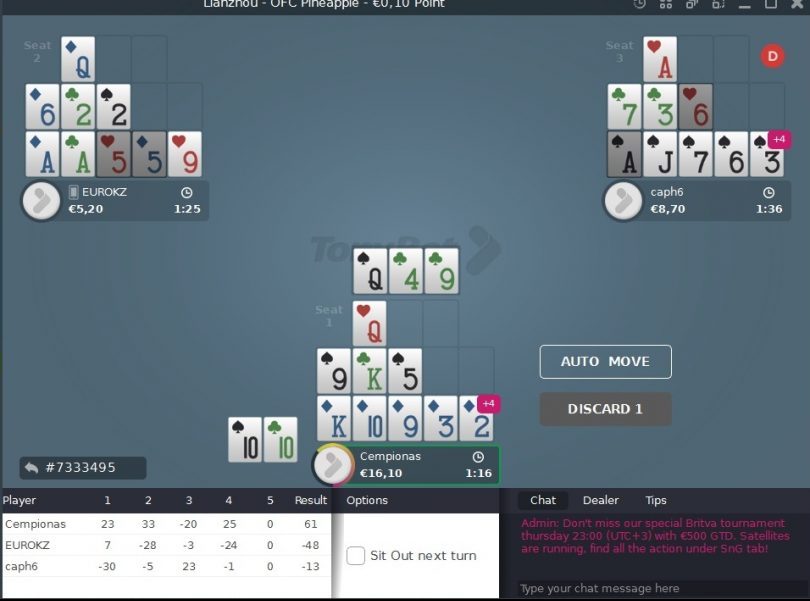
A specific example from my game. When I lay down these cards, there is only one last hand left, the last three cards, so I need to know very well whether it pays off for me before I make a decision. In this case, we have the bottom already sorted out, obviously the 9 will go in the middle, but what about the Q? After all, we only have one draw left and we're still blocking ourselves with one K. Should I put Q on top and take the risk? Or is it better to choose a safer line? I think that for many players this is a very familiar situation and most of the time we don't even have that 9. We only have Q and the question is whether to take the risk when there are only two K's left? So we will try to calculate these situations together with you.
First question: how many cars do we have? Aces are all the cards that suit us and can make our hand a winning one.
If we put QQ on top, we need to put something stronger than QQ in the middle, so all the remaining cards, whether K, 9 or 5, are good for us, so we need to calculate how many cards we have left in total. There are two free K / K left. All 9s are out. There is still one five, despite the fact that we have three live cards, we need to remember that both opponents have discarded two cards that we cannot see. Usually, high cards like A/K/Q/ are not discarded because they are used for fantasy or to reinforce the second line, but a lower card, in this case the 5, which is completely unnecessary for our opponents, could certainly have been discarded by one of them. So, we calculate that we have 2-3 outs. What is the next step? We need to find how many outs have %, i.e. what is the probability that one of those cards will be dealt to us. Most players, especially those who have played other types of poker, will tell you that 2-3 outs is nothing, but let's not rush to judgment.
How many cards are left in the deck? In total, we play with 52 cards. So both opponents have dealt 9 cards and have discarded 2 more. In this case, after our turn, we will have dealt 11 cards and discarded 3, for a total of 9+9+2+2+11+3 =36 cards. Or in other words 52-36 = 16 cards remaining in the deck.
What is the winning %? So, knowing how many cards we have and how many are left, it's easy to calculate how much % we will win. The simplest way to do this is with the following formula.
1 - (A/Z) x (A/Z) x (A/Z) =
A - cards that are not suitable for us
Z - all remaining cards
but don't be scared, it's the easiest formula in all of mathematics.
Let's go back to our specific example:
There are 16 cards remaining in the deck. This is Z = 16.
We have 3 suited cards and 16-3 = 13 unsuited cards. So A = 13. And the whole thing is repeated three times, so that we get three cards in our hand, which means that our chances increase that if we don't draw the K or 5 we need on the first card, it might be on the second card, or even on the third. So let's try to fit everything into our formula.
1 - (13/16) x ( 12/15) x (11/14) =
The first time we had 13/16, but in the second act we are one card down because we drew one. So we are left with 12/15, and even less in the third act, i.e. when the third card is drawn, there are only 14 cards in the deck, and 11 of them will be unsuitable.
Let's try to get %. For those who find division too complicated, you can use online calculators like this one: http://calculator.tutorvista.com/multiplying-3-fractions-calculator.html
1 - (13/16) x ( 12/15) x (11/14) = 0.489 = ~49%.
So we counted up all the remaining cards, counted up the cards that were good for us, and managed to find the probability of drawing the right card for us. In this situation, we have as much as ~49% to draw one of the cards that suit us. Pretty good right?
Simple formula, simple calculations, stunning results 🙂
To make your job even easier, I have attached a table of cars. Just note that our % is different from our position. The later our position, the fewer cards are left in the deck, the more likely we are to draw the right card.
Our analysis -> First position -> 16 cards remaining
1 car: 18.7%
2 cars: 35%
3 cars: 49%
4 cars: 60,7%
5 cars: 70,%
6 cars: 78.6
Middle position -> 13 cards remaining
1 car: 23,1%
2 cars: 42,3%
3 cars: 58%
4 cars: 70,6%
5 cars: 80,4%
6 cars: 87,8%
Late position - dealer - 11 cards remaining.
1 car: 33,6%
2 cars: 53.33%
3 cars: 70.83%
4 cars: 83,33%
5 cars: 91,66%
6 cars: 96,60%
That's a great start, but the maths of poker doesn't stop there. In our next article together, we'll explore further mathematical solutions to Chinese poker, trying to calculate EV.






